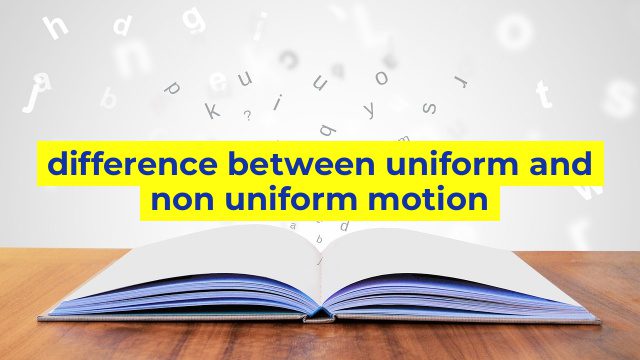The Difference Between Uniform and Non-Uniform Motion
What is Uniform Motion?
Uniform motion is the type of motion in which an object moves at a constant speed in a straight line. In other words, the object moves with uniform velocity, covering equal distances in equal intervals of time.
The best example of uniform motion is a car moving with a constant speed on a straight, level road. Another example is a spaceship traveling at a constant speed in a straight line.
In uniform motion, the distance traveled by an object in a given time depends on the speed of the object. Therefore, the equation used to calculate distance traveled in uniform motion is:
Distance traveled = Speed x Time
What is Non-Uniform Motion?
Non-uniform motion is the type of motion in which an object moves with varying speed. In other words, the object is accelerating or decelerating, and its velocity is changing with time.
The best example of non-uniform motion is a car moving in a city road, where it has to encounter traffic signals, speed bumps, and turns. The speed of the car varies, depending on the obstacles it faces on its path.
In non-uniform motion, the distance traveled by an object in a given time varies, as the speed of the object is not constant. Therefore, the equation used to calculate distance traveled in non-uniform motion is a bit complicated, as it involves calculus.
Which One is More Common?
Both uniform and non-uniform motion are common in our daily life. For instance, when we walk or run, we move with non-uniform motion, as the speed of our feet constantly changes. However, when we drive a car on a straight, level road with a constant speed, we move with uniform motion.
In conclusion, the primary difference between uniform and non-uniform motion is that the former is characterized by a constant speed and a straight line, while the latter is characterized by varying speed and frequently changing directions. Understanding this difference can help students better understand the principles of motion and how they relate to everyday life.
Table difference between uniform and non uniform motion
| Uniform Motion | Non-Uniform Motion |
|---|---|
| The object moves with a constant speed. | The object moves with varying speeds. |
| The object covers equal distances in equal intervals of time. | The object may cover unequal distances in equal intervals of time. |
| The velocity of the object remains constant throughout the motion. | The velocity of the object changes during the motion. |
| The acceleration of the object is zero. | The acceleration of the object may be positive, negative or zero. |
| Examples: A car moving at a constant speed on a highway, a train moving on a straight track with a constant speed. | Examples: A ball moving upwards and then downwards due to gravity, a car moving in a city with frequent stops and starts, a person jogging. |

